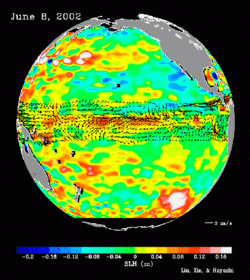El Niño

El Niño (English: The Niño) is a situation in which slight warming of the temperature of the Pacific Ocean wreaks holy Heck around the globe.
El Niño is Spanish for the baby; that is, the Christ child. The weather phenomenon is so named because the weird stuff starts happening around Christmas. The effects of El Niño are different every time it occurs. When the ocean doesn't warm slightly, scientists call it La Niña, which essentially is the female Christ child.
The reason the phenomenon is named in Spanish is that South America, which speaks it, is on the receiving end of the Pacific Ocean and, therefore, of El Niño.
Definition[edit | edit source]
El Niño occurs when surface temperatures of the Pacific Ocean vary by at least 0.5°C (0.9°F) from normal readings. (The phenomenon when frighteningly hot temperatures are sensed by the NASA global probe just above the asphalt parking lot of Pok-E-Joe's Brisket Buffet in Austin, Texas, has a different scientific name.)
La Niña occurs when they don't.
Observed effects of El Niño (or of La Niña) are as follows:
- There is a rise in surface air pressure.
- There are torrential rains in the coastal deserts of Peru, and the northern city of Chiclayo becomes known as the country's "island paradise."
- The supreme courts of at least two Latin American countries rule that the President can seek another term, no matter with the constitution says.
- At least one hundred people in an Andean village die because lunch milk for schoolchildren is mixed from powder in barrels that formerly contained insecticide.
- A four-person airplane on a relief mission from the United States goes down in the jungle and is suspected of being downed by narcotraficantes. The Army pursues but the results are inconclusive.
- There are earthquakes, landslides, gun massacres despite nationwide gun prohibition, day-long tie-ups on the coastal expressway, and a lot of pointing and shouting.
Finally (on El Niño only), the temperature changes induce all the fish in the ocean to swim to new locations where the fishermen can't find them, and the national economies of western South America go to hell.
Further effects in cities[edit | edit source]
Heavy rain in the affected cities has several other consequences:
- As the streets are much lower than the sidewalks, they effortlessly become canals and each driveway becomes a boat launch.
- As the sidewalks are slimy in normal times, they become unpassable.
The nuances of local garbage collection explain both of these effects. They both have potential for new amateur sports that have not been fully exploited; and on the local rat population, which have.
Cause and effect[edit | edit source]
As the effects of El Niño differ on each occurrence, and as we all know every year's weather is different anyway, science students might insist that it is hard to assert cause and effect. This is an outdated view, for two reasons:
- The science is settled, by a scientific consensus. (See Global warming.)
- We've got to do something, and soon! (Otherwise, it will be too late!)
Although the scientific consensus is that global warming is caused by industry, economic freedom, and Fox News, no one has claimed that El Niño is caused by these things. This is because Al Gore has bigger fish to fry.
It might be said that a lot of strange things happen on Earth, and El Niño is one of them. So a lot of strange things are correlated and coincident with El Niño. Formal cause and effect? We have a grant in for more funding.
Some confuse this effect with El Coño, but the latter's only relevance is to show that English is not the only language with a four-letter "C-word."
